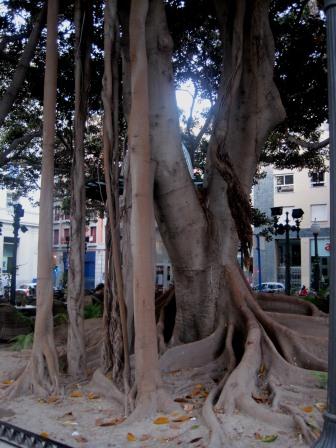I just got back from a 9 hour overseas flight, just in time to post the answer to last week’s quiz. So now you know…I wasn’t in the states. More on that later.
As many of you guessed, this is a fig tree (Ficus spp.) of some sort. I have horrendous taxonomic abilities anyway, but will cover my ignorance with the excuses that the tree wasn’t in flower, nor were there any signs in any of the little parks identifying the tree. So we can continue to speculate on what species this is. I do know it’s quite an old specimen, and that there are some Ficus native to the region, but past that I’m clueless as to whether this really is a native species or not.

And where was this huge tree? In Alicante, Spain, where I spent a few days visiting my daughter who’s studying there this semester. (Non-scientific aside: I would go back there in a heartbeat. If you are looking for a Mediterranean tourist destination that isn’t overrun with Americans, this is the place to go.)
Finally, these cool wavy woody structures are buttress roots, as Jospeh, Shawn, Rotem and Deb all pointed out. They have both a structural and storage function: like all woody roots they store carbohydrates, but the over-developed flare helps support the tree in thin soils (like here) or in wet, low-oxygen soils (like those where mangroves grow). In both cases roots can’t reach far enough below ground to stabilize the trunk, so the buttressing serves that function.
@Rotem also noted that branches can root and support the tree. While the buttress roots in the original photo arose from root tissue, you can see examples of the rooted branches in the photo above.
And I do love the less-than-serious answers some of you kindly provided for our amusement. Fred’s "rumble strips for drunks" was particularly apropos, since my last night there was one big street party after Barcelona beat Manchester United in the Champions League soccer match. My daughter and I ended up in our hotel elevator at 8 am the next morning with a fan with no pants. We did not ask.